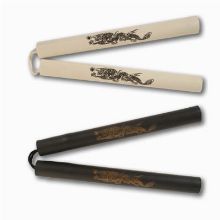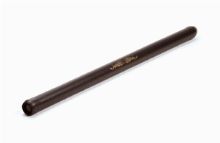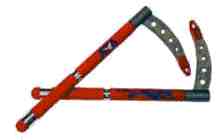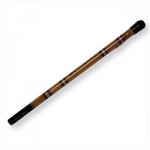The following are a list of the songahm taekwondo weapons approved for training in the American Taekwondo Association.
| Name |
Picture |
Information |
Ssahng Jeol Bong
(Nunchaku) |

 |
The Ssahng Jeol Bong is
comprised of two short sticks connected by rope or chain.? The
Ssahng Joel Bong can be practiced as a single or double weapon and
is admired for its speed and complex twirls.? Consistent practice
with the Ssahng Jeol Bong develops coordination and
conditions muscles, especially the muscles of the arms and
shoulders.
The Ssahng Jeol Bong, also
known as the Nunchuku, once served the farmer in harvesting
his crops by separating the grain from the shaft.? The farmer would
beat the crop with a tool that comprised of a long staff with a
shorter stick attached to the end by a rope.? During times of
fighting or war, this farm tool could easily be used as a weapon.
Often called a Chul Te or Dur Ree Ge, it worked very
similarly to a mace.? The length of the longer shaft allowed the
warrior to stay at a safer distance from his opponent and would also
aid in the generation of power in a strike.? As peace time
prevailed, the warriors, with little to do but train, fashioned the
Cuhl Te into smaller versions creating the design we are
familiar with today.
|
Bahng Mahng Ee
(Escrima Stick) |

 |
The Bahng Mahng Ee is a
short stick.? It can be practiced as a single or double weapon.
Practitioners like this weapon because of its challenging partner
drills and disarms.
The Bahng Mahng Ee was
originally used as a tool such as a leverage bar for an ancient
Korean ?backpack,? a laundry stick, and an ironing stick.? The
ironing stick has a very interesting history.? Folded cloth would be
placed on a flat rock surface and rhythmically struck with two
specially designed sticks in order to flatten the wrinkles out.? The
?ironing rock? often became a place for the women ? mother and
daughter or perhaps neighboring women ? to gather and work
together.? By listening to the rhythm of how a woman beat the
clothes, passersby could tell whether she was happy or sad.? The
daily chore of using the sticks to beat clothes conditioned the
upper body and taught the women how to strike forcefully and
efficiently.? It was only natural for the women to pick up one or
both of these sticks in the face of danger.
|
Jee Pahng Ee
(cane) |
 |
The
Jee Pahng Ee is an extremely effective weapon.? Of all the
weapons that were and, in some cases, still are implemented to aid
in daily domestic chores, the Jee Pahng Ee is the weapon that
is most commonly still in use as a tool.? The cane can be taken
anywhere because it is mainly implemented as a walking aid, and most
people are completely unaware that the cane can also be wielded as a
weapon.? The shaft of the cane is swung, using centrifugal force to
generate powerful strikes.? The curve of the crook and the walking
end of the cane are used for thrusts, and the crook is also used to
hook wrists and ankles.
|
Gum Do
(Sword) |
 |
Gumdo (Korean Sword) is designed
to give students a chance to train with the most famous of all the
martial art weapons.? Its purpose is to execute justice with
the light of the sword that is as majestic and brilliant as the
morning sunlight on the east sea.? It is a beautiful and powerful
art that originated some 1,700 years ago on Mt. Baekdu in Korea.? It
has been passed down through the ages, from warrior to warrior.Unlike other martial arts, Gumdo doesn’t require advanced
athletic prowess, so it’s the perfect martial art for all ages.
Students learn how to perform sword forms and one-step combinations,
as well as methods in which to draw and sheathe their swords.
Advanced Students may also practice sword self defense techniques,
bamboo cutting and candle extinguishing.? Overall, a student will
develop balance, coordination, concentration and focus through
training with the Gumdo. |
Sahm Dam Bong
(3-Section Staff) |
 |
The three-section staff is one
of the most difficult and versatile weapons within Taekwondo. More
prevalent in Northern Systems, the three-section staff can be used
as both a close-quarters weapon, a trapping weapon and as a
long-range flexible whip-like weapon. |
Sahn Knat
(Kama) |
 |
The Sahn Knat or Kama are
traditional farming implements similar to a sickle used for reaping
crops and also employed as a weapon. Before being used in martial
arts, the Sahn Knat was widely used to cut crops, mostly rice. The
Sahn Knat is a formidable weapon, traditionally used in pairs,
though in agricultural use it would be used one-handed, whilst the
other hand grasped the stalks for cutting.? As a weapon, both
the point and sharpened edge of the metal blade are called in to
use, while the Sahn Knat could also be used to block, trap and
disarm weapons used against the wielder. The hard edge of the Sahn
Knat blade would traditionally be kept razor-sharp to enable
efficient cutting of crops, which made it a lethal weapon in the
right hands, though this is sometimes a cause of training accidents
by unskilled wielders, for whom blunt training versions of the
weapon are created. It is also a popular modern forms competition
weapon. |
Jahng Bong
(Staff) |
 |
The Jahng Bong was used in
daily domestic chores and doubled as an effective weapon against
larger or multiple opponents at increased range.? The Jahng Bong
uses leverage to generate powerful strikes the proper execution of
which increases upper body and core strength.? (The Jahng Bong,
is essentially a leaver, a slight motion by the user results in
a faster, more forceful motion at the tip; thus enabling long-rang
crushing and sweeping strikes.) ?The Jahng Bong, may also be
used for thrusting strikes and for joint-locks. The Eighth degree
black belt Master G. K. Lee says of the Jahng Bong,
?Personally, I think this is one of the most beautiful weapons to
watch or use.? The combination of strength and skill needed to make
it a truly effective weapon makes it one of the most respected of
all weapons.?
|
| Dragon Wind Staff |
 |
The Dragon Wind Staff, commonly referred to as a Wind Staff, is a telescoping staff.? When collapsed is 24″ in length, and when expanded is 6′.
The telescopic staff is a popular innovation, and was often disguised as a scroll tube. With the touch of a button, it instantly telescopes out to form a 6? staff. Pressing the button again causes the internal spring mechanism to retract the staff.
A telescopic staff is a double weapon. You can fight with it as if fighting with two weapons,? a one-handed lighting fast strike weapon or a powerful two handed (long reaching) bo-staff.
Please note as of November, 2009 this Protech weapon is NOT allowed for use in any ATA tournament (including XMA or Creative). |
READ MORE
![forms[1] forms[1]](http://www.performancemartialartsacademy.com/wp-content/uploads/sites/2/forms1-300x70.png)
In Songahm Taekwondo, each rank has its own unique poom-sae (form) designed specifically for the techniques taught at that rank level. The form is part of a complete system of teaching the Songahm Taekwondo student.
Why must students learn forms? Many martial art styles have discontinued the use of the poom-sae or use them only for the purpose of testing or tournaments. This means they have taken the “do” (as in TaekwonDO), which means “the way”, out of their style. They have in essence taken the “art” out of “martial art.”
FORMS / POOM-SAE
The Korean word “poom-sae” means a “form” or “pattern of movements.” It is actually a planned series of movements that combines the physical skills (such as blocks, strikes, kicks, stances and more) with the mental skills (such as balance, coordination, discipline, strategy, focus and more). The target of these movements is an imaginary opponent of the practitioner’s own size.
The copyrighted Songahm forms have been arranged as a system to gradually increase the student’s skill, develop technical balance equally on the left and right side of the body, train muscles, and to develop students from the beginner level through the rank of Grand Master. This is why each Songahm form does not repeat most techniques more than twice and also why every technique which is done with a right arm/leg is also repeated with the left arm/leg.
These forms, designed by Eternal Grand Master H.U. Lee, were the first that truly emphasized the tradition of the art of Taekwondo, unlike older forms (hyung) which were based on Japanese and Okinawan Karate forms. Not only do the Songahm forms train you in each rank, but they are also excellent for using as a warm-up prior to a work out.
The “system” that encompasses the 18 Songahm forms is based on traditional philosophy, as well as being designed for for easy memorization.
FORM PHILOSOPHY
All goals require a poom-sae or pattern. Even in life we have structured patterns. When you’re born, you learn communication and basic skills in the home. A few years later, you are enrolled into kindergarten or elementary school. Following this comes high school. During high school, we begin to decide the direction we will take in life. We choose a college and/or a career goal. This is the pattern of the first part of our life. If you choose a good pattern, you can be a success. If your pattern is poor, you may not be as successful in your life endeavors.
Similarly, your chances of success in Songahm Taekwondo are much greater by following the solid series of patterns (forms) we have developed for our students.
READ MORE










![forms[1] forms[1]](http://www.performancemartialartsacademy.com/wp-content/uploads/sites/2/forms1-300x70.png)